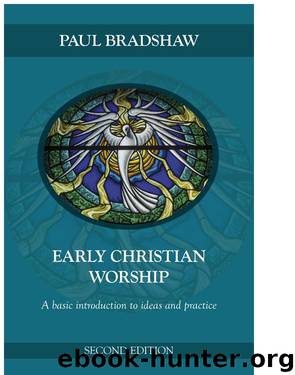EARLY CHRISTIAN WORSHIP by Unknown

Author:Unknown
Language: eng
Format: epub
Published: 2019-11-18T16:00:00+00:00
8
Holy food
There is another strand of thought present in the New Testament which would be strongly developed in later centuries, and that focuses not on the meal as event, but on the bread and wine themselves as spiritual food. We can perhaps even see this emerging in the difference between the remembered words of Jesus over the cup of wine in Paul and in Mark. Paul recalls the words as being ‘this cup is the new covenant in my blood’ (1 Corinthians 11.25), suggesting a vision of the Eucharist as effective action, the shared meal sealing a covenant between God and those partaking of it which had been made by the shedding of the blood of Jesus, just as in the Old Testament covenants were sealed in sacrificial blood. Mark’s version, on the other hand, speaks more directly of the wine as ‘This is my blood of the covenant’ (14.24), which seems to imply that the presence of the Lord was attached to the food rather than to the meal event. This way of thinking is even more clearly revealed in the ‘I am the bread of life’ discourse of John 6.
Alongside their continuing understanding of the Eucharist as a communal action, therefore, the writings of the second and third centuries also develop this way of thinking. Thus, for example, one of the prayers in the Didache speaks of the gift of ‘spiritual food and drink’ (above, p. 51); and Justin Martyr provides the earliest example of the food rather than the rite being called eucharistia, and goes on to say:
We do not receive these things as common bread or common drink; but just as our Savior Jesus Christ, being incarnate through the word of God, took flesh and blood for our salvation, so too we have been taught that the food over which thanks have been given by a word of prayer which is from him, from which our flesh and blood are fed by transformation, is both the flesh and blood of that incarnate Jesus.1
Justin is also the first to describe the custom of the bread and wine from the Sunday Eucharist being taken to those unable to be present at it (First Apology 65.5; 67.5), while Tertullian at the end of the second century refers to those present at the celebration also taking bread home for consumption there during the week (Ad uxorem 2.5; cf. also De oratione 19). Both these practices continue to be attested by later sources, sometimes with bread alone, and sometimes with wine as well, though difficulties in transporting and storing the latter safely made it less common. Their origin almost certainly lies in the desire mentioned above (p. 43) to ensure that the poor in the Christian community might be adequately fed, and so enough would have been given to them by these means to help satisfy their physical hunger every day. Later, when communion was reduced to token amounts, it would have continued to be shared with those who were absent and also taken home by some believers as a way of feeding spiritually on Christ each day.
Download
This site does not store any files on its server. We only index and link to content provided by other sites. Please contact the content providers to delete copyright contents if any and email us, we'll remove relevant links or contents immediately.
Kathy Andrews Collection by Kathy Andrews(11730)
The remains of the day by Kazuo Ishiguro(8820)
Paper Towns by Green John(5089)
Spare by Prince Harry The Duke of Sussex(5072)
Industrial Automation from Scratch: A hands-on guide to using sensors, actuators, PLCs, HMIs, and SCADA to automate industrial processes by Olushola Akande(4978)
The Body: A Guide for Occupants by Bill Bryson(4974)
Machine Learning at Scale with H2O by Gregory Keys | David Whiting(4178)
Be in a Treehouse by Pete Nelson(3945)
Never by Ken Follett(3789)
Harry Potter and the Goblet Of Fire by J.K. Rowling(3773)
Goodbye Paradise(3727)
Into Thin Air by Jon Krakauer(3311)
The Remains of the Day by Kazuo Ishiguro(3293)
The Cellar by Natasha Preston(3260)
The Genius of Japanese Carpentry by Azby Brown(3224)
Fairy Tale by Stephen King(3220)
120 Days of Sodom by Marquis de Sade(3179)
The Man Who Died Twice by Richard Osman(2997)
Drawing Shortcuts: Developing Quick Drawing Skills Using Today's Technology by Leggitt Jim(2996)
